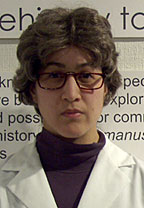
A Welcome from Dr. Georgiana Mendell (representing the exhibit's corporate sponsor, BIOMANUX)
Gallery Talk
(March 6, 2003 at Beelke Gallery, W. Lafayette IN)
PART I BIOMANUX rep Dr. Mendell | PART II Exhibition Designer Christine Chin
 |
A Welcome from Dr. Georgiana Mendell (representing the exhibit's corporate sponsor, BIOMANUX) |
| Welcome. I’m
Dr Georgiana Mendell, Vice President of Research at Biomanux, and I am pleased
to welcome you on behalf of our company.
For the last 10 years, the name Biomanux has been synonymous with high-quality, innovative science that strives to bring humanity closer to the plant world. We are a leading institution in the exciting field of transgenics. As you all know, transgenics refers to the transfer of genetic material from one species to another, and the creative possibilities of such transfer are limitless. When you consider that the same four proteins are the key to the structure of all living organisms on earth, the difference between plant cells having cell walls and animal cells having centrioles is rather minor. And the real benefit with science is that we can create new species in a matter of months or years, improving greatly on the geological time span of evolution. I regret that I am unable to specifically address our company’s research with the Vernomanus organisms—our research is not at a point where we feel comfortable disclosing details into a very competitive field. However, our recent success with transgenic and hybrid digitulus and brevicaulis species have prompted us to switch over 90 percent of our research facilities to research and development in this area. I am certain that Biomanux Vernomanus products will be familiar to you in the span of just a few years. With our focus at Biomanux firmly set on the future, it is a unique opportunity to explore the past in this special exhibition. With the Vernomanus species being a rather obscure and elusive group, we thought that it would be beneficial to publicize their natural history. We are very lucky to have some rare Vernomanus fossils here from the Museum of Vegetable Physiology. They have the largest collection of Vernomanus fossils in the world, and have published some rather fascinating papers on the smooth-stemmed Vernomanus habilis and the emergence of the ancestors of modern humanity, both recorded in the fossil record around 6 million years ago. We also have a remarkable collection of photographs from the 19th century of the long-stemmed Vernomanus species that inexplicably declined around the turn of the century. And I am sure you have all taken note of the wonderful collection of photographs of Vernomanus brevicaulis and aquatica in their natural habitats. It is a shame that we do not know to whom to attribute this excellent documentation, but we are fortunate to have the images well preserved. I will now
cede the podium to our exhibit designer, Miss Christine Chin, who will
talk to you about some particulars of the artifacts presented today. But
while she is making her way up here, please take a few minutes to view
the time lapse images of the natural growth patterns of the long-stemmed
Vernomanus. |